Bio 112 - Cystic Fibrosis: Genetic Disorder, Symptoms & Treatments
VerifiedAdded on 2023/06/10
|6
|1751
|377
Report
AI Summary
This report provides a comprehensive overview of cystic fibrosis, a progressive genetic disorder causing persistent lung infections and impacting breathing. It explores the causes, primarily mutations in the CFTR gene affecting salt and fluid movement in cells, leading to thick mucus in the respiratory, digestive, and reproductive systems. Risk factors, including family history, are discussed, along with symptoms such as persistent cough, wheezing, digestive issues, and high salt levels in sweat. The report also details treatment therapies like airway clearance, inhaled medicines, and pancreatic enzyme supplements, emphasizing the importance of individualized treatment plans for managing symptoms and improving the quality of life for individuals with cystic fibrosis. The report uses references to support its claims and provide further reading for those interested in learning more about this complex condition.
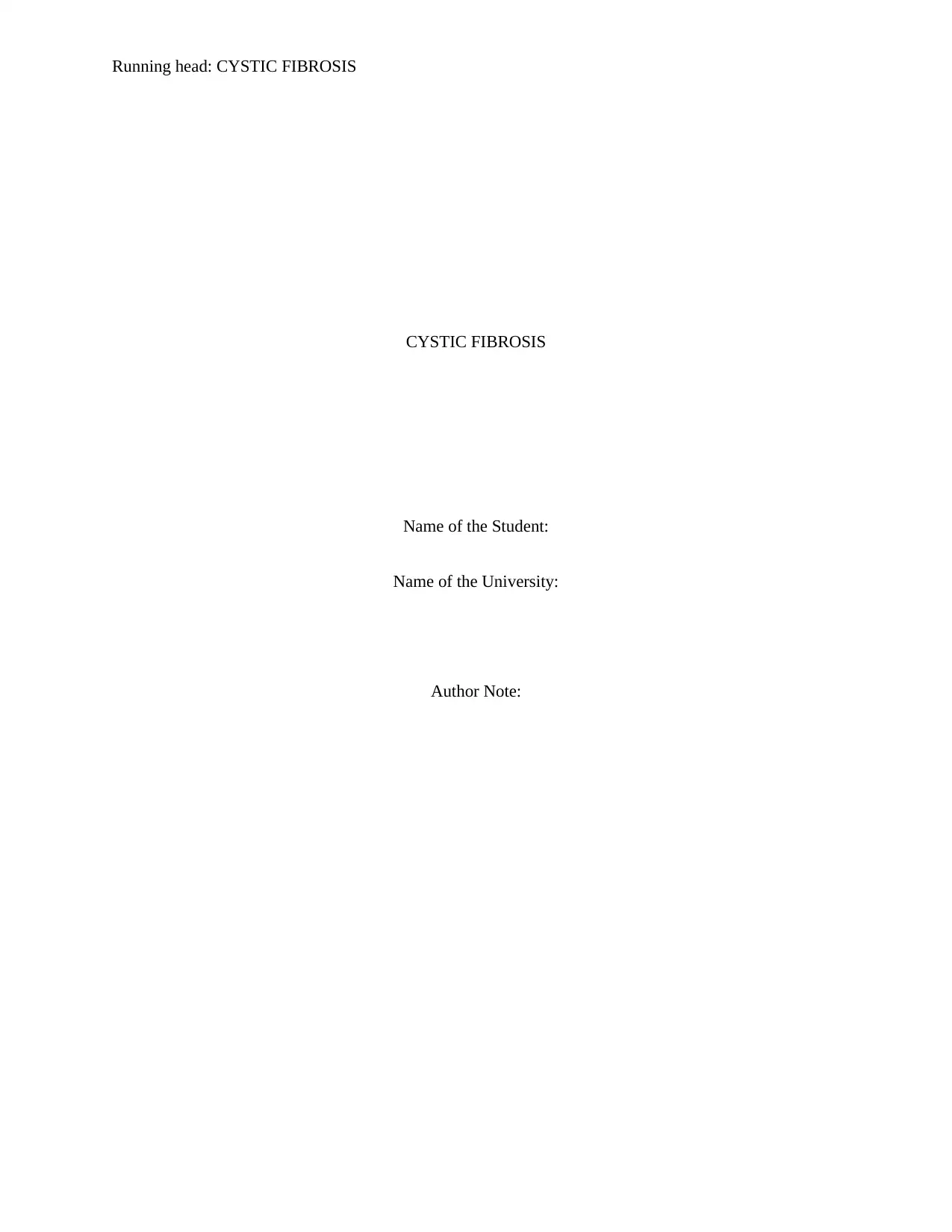
Running head: CYSTIC FIBROSIS
CYSTIC FIBROSIS
Name of the Student:
Name of the University:
Author Note:
CYSTIC FIBROSIS
Name of the Student:
Name of the University:
Author Note:
Paraphrase This Document
Need a fresh take? Get an instant paraphrase of this document with our AI Paraphraser
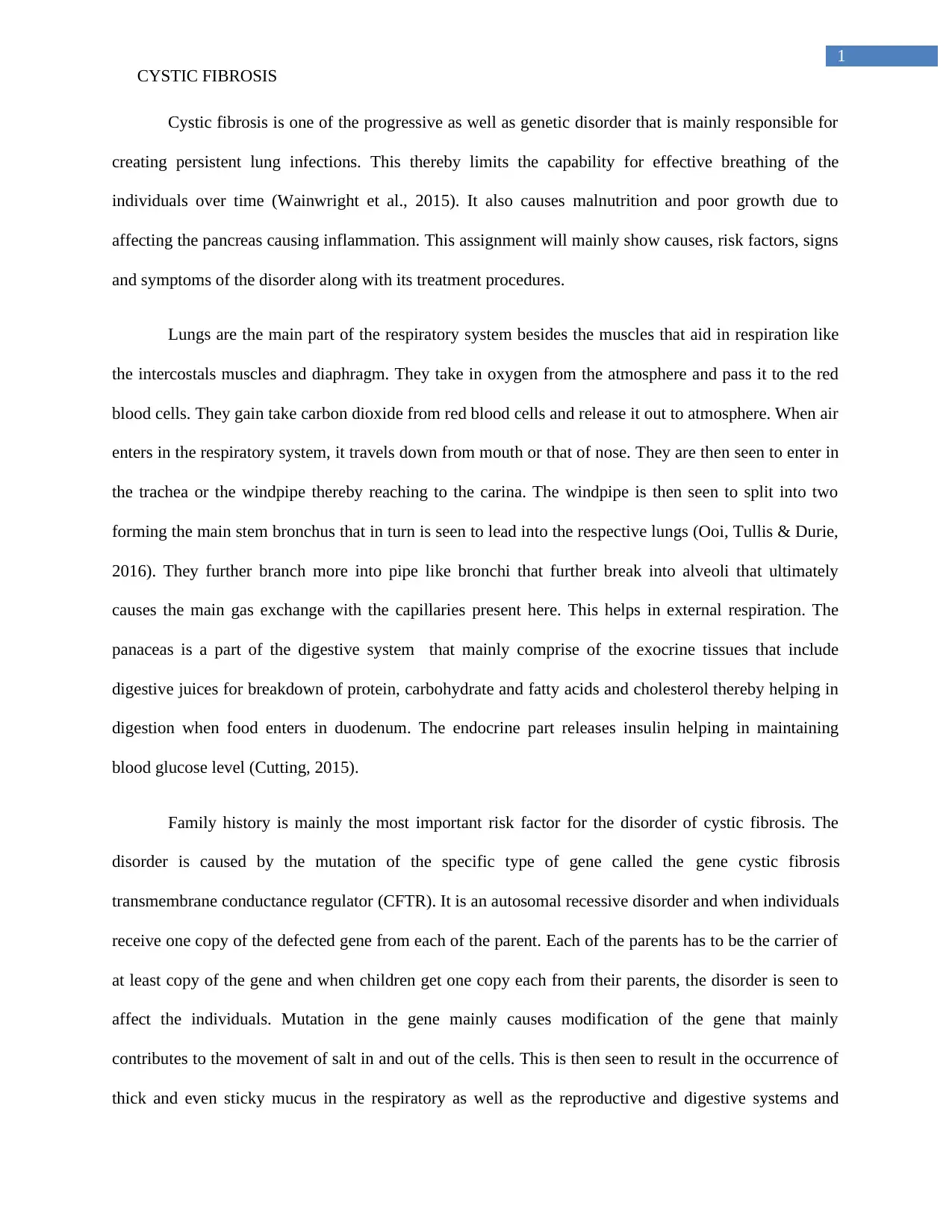
1
CYSTIC FIBROSIS
Cystic fibrosis is one of the progressive as well as genetic disorder that is mainly responsible for
creating persistent lung infections. This thereby limits the capability for effective breathing of the
individuals over time (Wainwright et al., 2015). It also causes malnutrition and poor growth due to
affecting the pancreas causing inflammation. This assignment will mainly show causes, risk factors, signs
and symptoms of the disorder along with its treatment procedures.
Lungs are the main part of the respiratory system besides the muscles that aid in respiration like
the intercostals muscles and diaphragm. They take in oxygen from the atmosphere and pass it to the red
blood cells. They gain take carbon dioxide from red blood cells and release it out to atmosphere. When air
enters in the respiratory system, it travels down from mouth or that of nose. They are then seen to enter in
the trachea or the windpipe thereby reaching to the carina. The windpipe is then seen to split into two
forming the main stem bronchus that in turn is seen to lead into the respective lungs (Ooi, Tullis & Durie,
2016). They further branch more into pipe like bronchi that further break into alveoli that ultimately
causes the main gas exchange with the capillaries present here. This helps in external respiration. The
panaceas is a part of the digestive system that mainly comprise of the exocrine tissues that include
digestive juices for breakdown of protein, carbohydrate and fatty acids and cholesterol thereby helping in
digestion when food enters in duodenum. The endocrine part releases insulin helping in maintaining
blood glucose level (Cutting, 2015).
Family history is mainly the most important risk factor for the disorder of cystic fibrosis. The
disorder is caused by the mutation of the specific type of gene called the gene cystic fibrosis
transmembrane conductance regulator (CFTR). It is an autosomal recessive disorder and when individuals
receive one copy of the defected gene from each of the parent. Each of the parents has to be the carrier of
at least copy of the gene and when children get one copy each from their parents, the disorder is seen to
affect the individuals. Mutation in the gene mainly causes modification of the gene that mainly
contributes to the movement of salt in and out of the cells. This is then seen to result in the occurrence of
thick and even sticky mucus in the respiratory as well as the reproductive and digestive systems and
CYSTIC FIBROSIS
Cystic fibrosis is one of the progressive as well as genetic disorder that is mainly responsible for
creating persistent lung infections. This thereby limits the capability for effective breathing of the
individuals over time (Wainwright et al., 2015). It also causes malnutrition and poor growth due to
affecting the pancreas causing inflammation. This assignment will mainly show causes, risk factors, signs
and symptoms of the disorder along with its treatment procedures.
Lungs are the main part of the respiratory system besides the muscles that aid in respiration like
the intercostals muscles and diaphragm. They take in oxygen from the atmosphere and pass it to the red
blood cells. They gain take carbon dioxide from red blood cells and release it out to atmosphere. When air
enters in the respiratory system, it travels down from mouth or that of nose. They are then seen to enter in
the trachea or the windpipe thereby reaching to the carina. The windpipe is then seen to split into two
forming the main stem bronchus that in turn is seen to lead into the respective lungs (Ooi, Tullis & Durie,
2016). They further branch more into pipe like bronchi that further break into alveoli that ultimately
causes the main gas exchange with the capillaries present here. This helps in external respiration. The
panaceas is a part of the digestive system that mainly comprise of the exocrine tissues that include
digestive juices for breakdown of protein, carbohydrate and fatty acids and cholesterol thereby helping in
digestion when food enters in duodenum. The endocrine part releases insulin helping in maintaining
blood glucose level (Cutting, 2015).
Family history is mainly the most important risk factor for the disorder of cystic fibrosis. The
disorder is caused by the mutation of the specific type of gene called the gene cystic fibrosis
transmembrane conductance regulator (CFTR). It is an autosomal recessive disorder and when individuals
receive one copy of the defected gene from each of the parent. Each of the parents has to be the carrier of
at least copy of the gene and when children get one copy each from their parents, the disorder is seen to
affect the individuals. Mutation in the gene mainly causes modification of the gene that mainly
contributes to the movement of salt in and out of the cells. This is then seen to result in the occurrence of
thick and even sticky mucus in the respiratory as well as the reproductive and digestive systems and
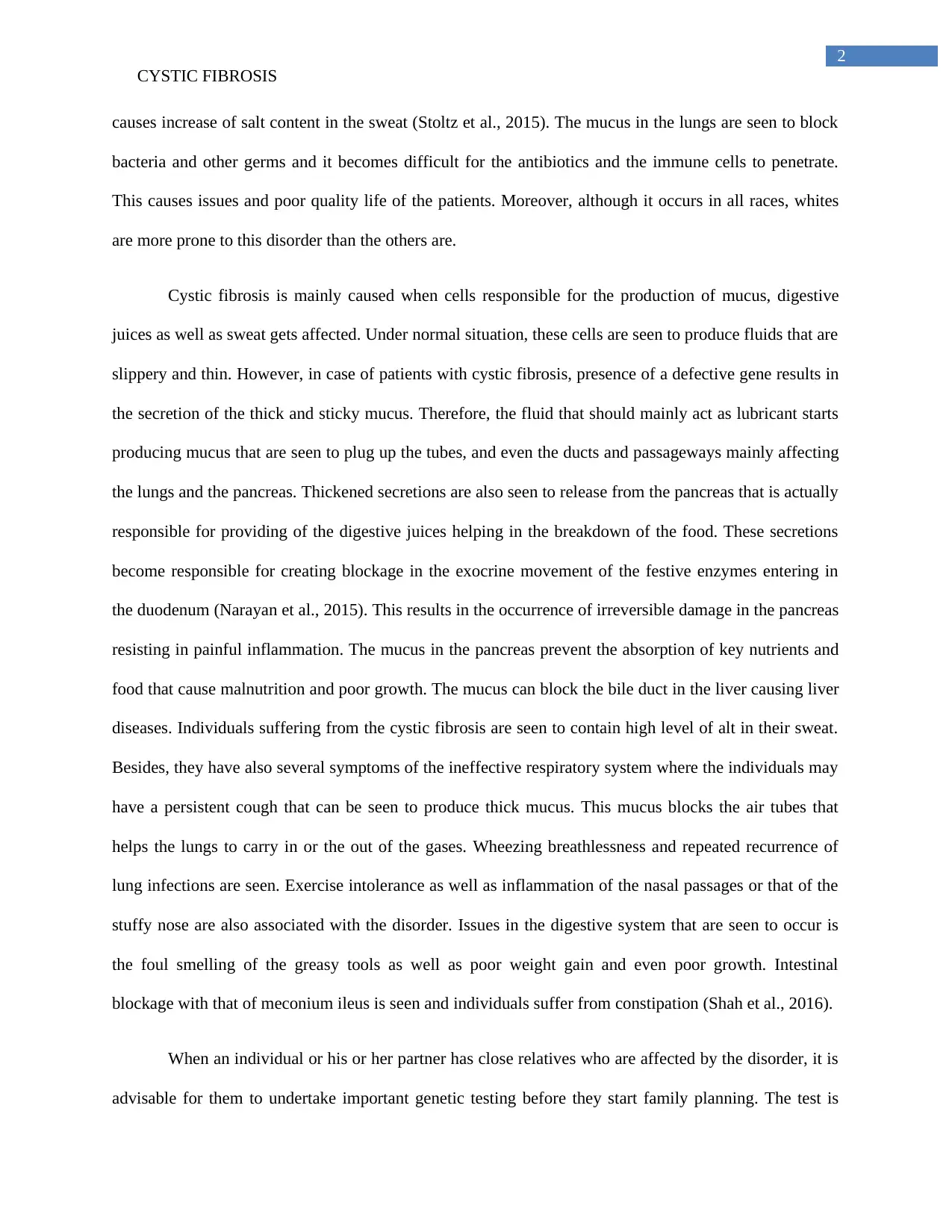
2
CYSTIC FIBROSIS
causes increase of salt content in the sweat (Stoltz et al., 2015). The mucus in the lungs are seen to block
bacteria and other germs and it becomes difficult for the antibiotics and the immune cells to penetrate.
This causes issues and poor quality life of the patients. Moreover, although it occurs in all races, whites
are more prone to this disorder than the others are.
Cystic fibrosis is mainly caused when cells responsible for the production of mucus, digestive
juices as well as sweat gets affected. Under normal situation, these cells are seen to produce fluids that are
slippery and thin. However, in case of patients with cystic fibrosis, presence of a defective gene results in
the secretion of the thick and sticky mucus. Therefore, the fluid that should mainly act as lubricant starts
producing mucus that are seen to plug up the tubes, and even the ducts and passageways mainly affecting
the lungs and the pancreas. Thickened secretions are also seen to release from the pancreas that is actually
responsible for providing of the digestive juices helping in the breakdown of the food. These secretions
become responsible for creating blockage in the exocrine movement of the festive enzymes entering in
the duodenum (Narayan et al., 2015). This results in the occurrence of irreversible damage in the pancreas
resisting in painful inflammation. The mucus in the pancreas prevent the absorption of key nutrients and
food that cause malnutrition and poor growth. The mucus can block the bile duct in the liver causing liver
diseases. Individuals suffering from the cystic fibrosis are seen to contain high level of alt in their sweat.
Besides, they have also several symptoms of the ineffective respiratory system where the individuals may
have a persistent cough that can be seen to produce thick mucus. This mucus blocks the air tubes that
helps the lungs to carry in or the out of the gases. Wheezing breathlessness and repeated recurrence of
lung infections are seen. Exercise intolerance as well as inflammation of the nasal passages or that of the
stuffy nose are also associated with the disorder. Issues in the digestive system that are seen to occur is
the foul smelling of the greasy tools as well as poor weight gain and even poor growth. Intestinal
blockage with that of meconium ileus is seen and individuals suffer from constipation (Shah et al., 2016).
When an individual or his or her partner has close relatives who are affected by the disorder, it is
advisable for them to undertake important genetic testing before they start family planning. The test is
CYSTIC FIBROSIS
causes increase of salt content in the sweat (Stoltz et al., 2015). The mucus in the lungs are seen to block
bacteria and other germs and it becomes difficult for the antibiotics and the immune cells to penetrate.
This causes issues and poor quality life of the patients. Moreover, although it occurs in all races, whites
are more prone to this disorder than the others are.
Cystic fibrosis is mainly caused when cells responsible for the production of mucus, digestive
juices as well as sweat gets affected. Under normal situation, these cells are seen to produce fluids that are
slippery and thin. However, in case of patients with cystic fibrosis, presence of a defective gene results in
the secretion of the thick and sticky mucus. Therefore, the fluid that should mainly act as lubricant starts
producing mucus that are seen to plug up the tubes, and even the ducts and passageways mainly affecting
the lungs and the pancreas. Thickened secretions are also seen to release from the pancreas that is actually
responsible for providing of the digestive juices helping in the breakdown of the food. These secretions
become responsible for creating blockage in the exocrine movement of the festive enzymes entering in
the duodenum (Narayan et al., 2015). This results in the occurrence of irreversible damage in the pancreas
resisting in painful inflammation. The mucus in the pancreas prevent the absorption of key nutrients and
food that cause malnutrition and poor growth. The mucus can block the bile duct in the liver causing liver
diseases. Individuals suffering from the cystic fibrosis are seen to contain high level of alt in their sweat.
Besides, they have also several symptoms of the ineffective respiratory system where the individuals may
have a persistent cough that can be seen to produce thick mucus. This mucus blocks the air tubes that
helps the lungs to carry in or the out of the gases. Wheezing breathlessness and repeated recurrence of
lung infections are seen. Exercise intolerance as well as inflammation of the nasal passages or that of the
stuffy nose are also associated with the disorder. Issues in the digestive system that are seen to occur is
the foul smelling of the greasy tools as well as poor weight gain and even poor growth. Intestinal
blockage with that of meconium ileus is seen and individuals suffer from constipation (Shah et al., 2016).
When an individual or his or her partner has close relatives who are affected by the disorder, it is
advisable for them to undertake important genetic testing before they start family planning. The test is
⊘ This is a preview!⊘
Do you want full access?
Subscribe today to unlock all pages.

Trusted by 1+ million students worldwide
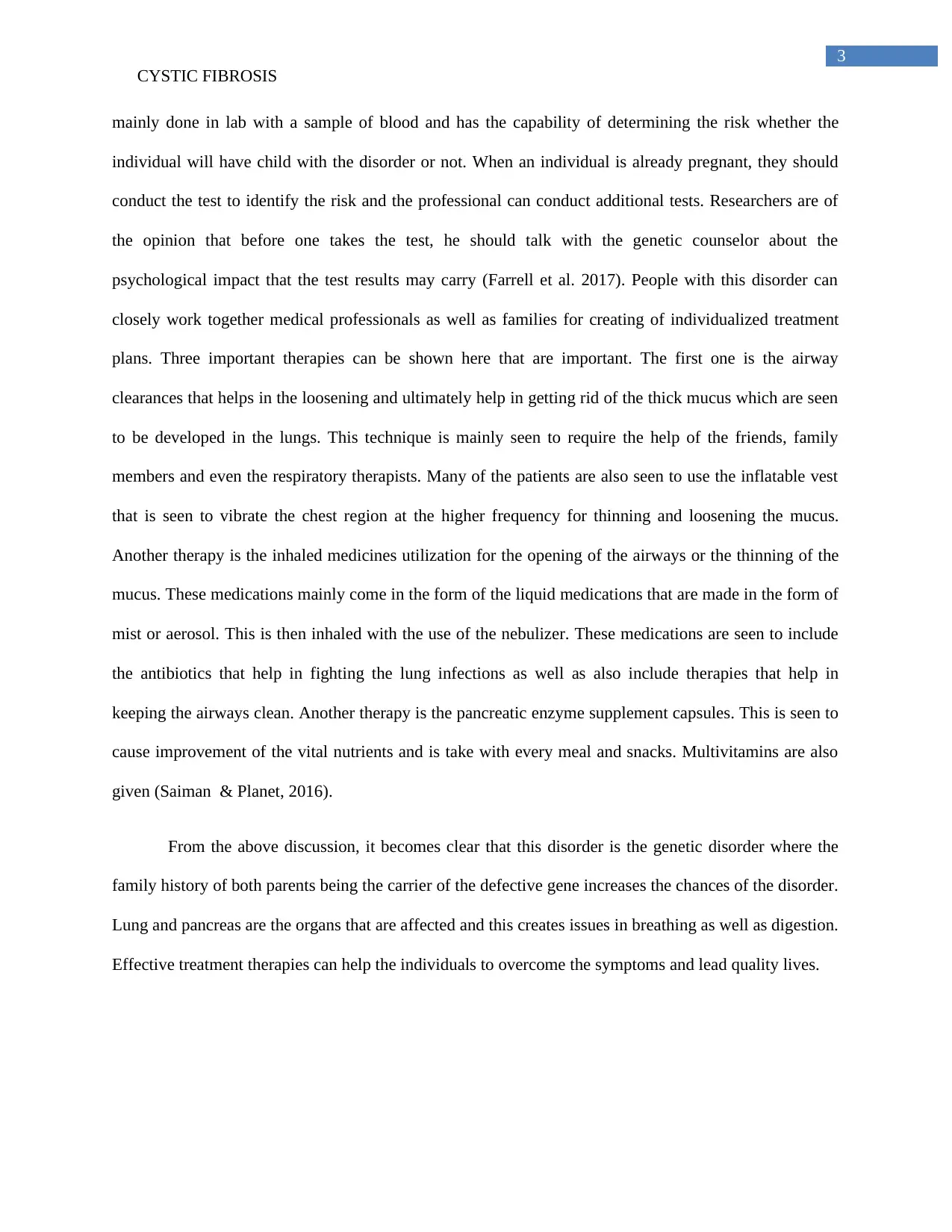
3
CYSTIC FIBROSIS
mainly done in lab with a sample of blood and has the capability of determining the risk whether the
individual will have child with the disorder or not. When an individual is already pregnant, they should
conduct the test to identify the risk and the professional can conduct additional tests. Researchers are of
the opinion that before one takes the test, he should talk with the genetic counselor about the
psychological impact that the test results may carry (Farrell et al. 2017). People with this disorder can
closely work together medical professionals as well as families for creating of individualized treatment
plans. Three important therapies can be shown here that are important. The first one is the airway
clearances that helps in the loosening and ultimately help in getting rid of the thick mucus which are seen
to be developed in the lungs. This technique is mainly seen to require the help of the friends, family
members and even the respiratory therapists. Many of the patients are also seen to use the inflatable vest
that is seen to vibrate the chest region at the higher frequency for thinning and loosening the mucus.
Another therapy is the inhaled medicines utilization for the opening of the airways or the thinning of the
mucus. These medications mainly come in the form of the liquid medications that are made in the form of
mist or aerosol. This is then inhaled with the use of the nebulizer. These medications are seen to include
the antibiotics that help in fighting the lung infections as well as also include therapies that help in
keeping the airways clean. Another therapy is the pancreatic enzyme supplement capsules. This is seen to
cause improvement of the vital nutrients and is take with every meal and snacks. Multivitamins are also
given (Saiman & Planet, 2016).
From the above discussion, it becomes clear that this disorder is the genetic disorder where the
family history of both parents being the carrier of the defective gene increases the chances of the disorder.
Lung and pancreas are the organs that are affected and this creates issues in breathing as well as digestion.
Effective treatment therapies can help the individuals to overcome the symptoms and lead quality lives.
CYSTIC FIBROSIS
mainly done in lab with a sample of blood and has the capability of determining the risk whether the
individual will have child with the disorder or not. When an individual is already pregnant, they should
conduct the test to identify the risk and the professional can conduct additional tests. Researchers are of
the opinion that before one takes the test, he should talk with the genetic counselor about the
psychological impact that the test results may carry (Farrell et al. 2017). People with this disorder can
closely work together medical professionals as well as families for creating of individualized treatment
plans. Three important therapies can be shown here that are important. The first one is the airway
clearances that helps in the loosening and ultimately help in getting rid of the thick mucus which are seen
to be developed in the lungs. This technique is mainly seen to require the help of the friends, family
members and even the respiratory therapists. Many of the patients are also seen to use the inflatable vest
that is seen to vibrate the chest region at the higher frequency for thinning and loosening the mucus.
Another therapy is the inhaled medicines utilization for the opening of the airways or the thinning of the
mucus. These medications mainly come in the form of the liquid medications that are made in the form of
mist or aerosol. This is then inhaled with the use of the nebulizer. These medications are seen to include
the antibiotics that help in fighting the lung infections as well as also include therapies that help in
keeping the airways clean. Another therapy is the pancreatic enzyme supplement capsules. This is seen to
cause improvement of the vital nutrients and is take with every meal and snacks. Multivitamins are also
given (Saiman & Planet, 2016).
From the above discussion, it becomes clear that this disorder is the genetic disorder where the
family history of both parents being the carrier of the defective gene increases the chances of the disorder.
Lung and pancreas are the organs that are affected and this creates issues in breathing as well as digestion.
Effective treatment therapies can help the individuals to overcome the symptoms and lead quality lives.
Paraphrase This Document
Need a fresh take? Get an instant paraphrase of this document with our AI Paraphraser
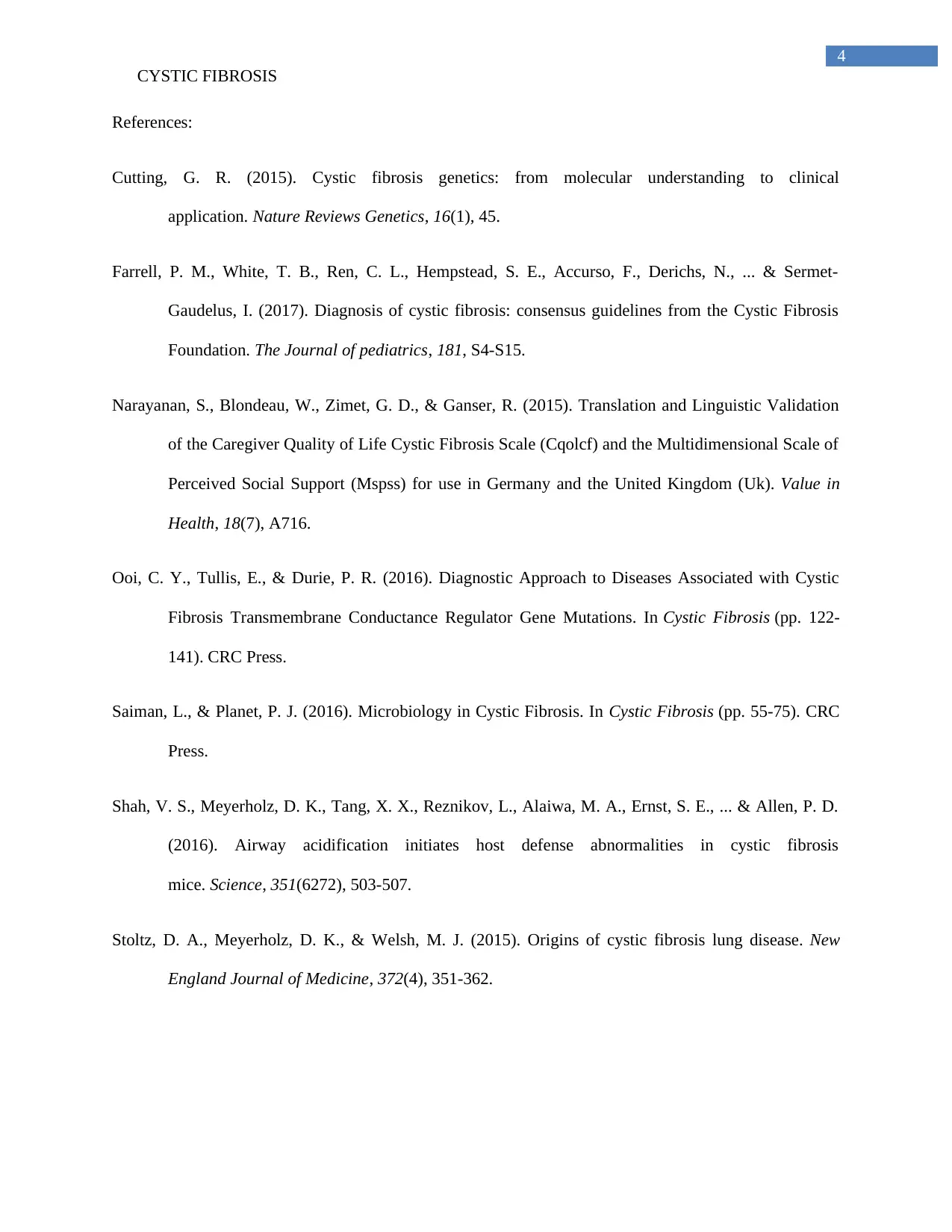
4
CYSTIC FIBROSIS
References:
Cutting, G. R. (2015). Cystic fibrosis genetics: from molecular understanding to clinical
application. Nature Reviews Genetics, 16(1), 45.
Farrell, P. M., White, T. B., Ren, C. L., Hempstead, S. E., Accurso, F., Derichs, N., ... & Sermet-
Gaudelus, I. (2017). Diagnosis of cystic fibrosis: consensus guidelines from the Cystic Fibrosis
Foundation. The Journal of pediatrics, 181, S4-S15.
Narayanan, S., Blondeau, W., Zimet, G. D., & Ganser, R. (2015). Translation and Linguistic Validation
of the Caregiver Quality of Life Cystic Fibrosis Scale (Cqolcf) and the Multidimensional Scale of
Perceived Social Support (Mspss) for use in Germany and the United Kingdom (Uk). Value in
Health, 18(7), A716.
Ooi, C. Y., Tullis, E., & Durie, P. R. (2016). Diagnostic Approach to Diseases Associated with Cystic
Fibrosis Transmembrane Conductance Regulator Gene Mutations. In Cystic Fibrosis (pp. 122-
141). CRC Press.
Saiman, L., & Planet, P. J. (2016). Microbiology in Cystic Fibrosis. In Cystic Fibrosis (pp. 55-75). CRC
Press.
Shah, V. S., Meyerholz, D. K., Tang, X. X., Reznikov, L., Alaiwa, M. A., Ernst, S. E., ... & Allen, P. D.
(2016). Airway acidification initiates host defense abnormalities in cystic fibrosis
mice. Science, 351(6272), 503-507.
Stoltz, D. A., Meyerholz, D. K., & Welsh, M. J. (2015). Origins of cystic fibrosis lung disease. New
England Journal of Medicine, 372(4), 351-362.
CYSTIC FIBROSIS
References:
Cutting, G. R. (2015). Cystic fibrosis genetics: from molecular understanding to clinical
application. Nature Reviews Genetics, 16(1), 45.
Farrell, P. M., White, T. B., Ren, C. L., Hempstead, S. E., Accurso, F., Derichs, N., ... & Sermet-
Gaudelus, I. (2017). Diagnosis of cystic fibrosis: consensus guidelines from the Cystic Fibrosis
Foundation. The Journal of pediatrics, 181, S4-S15.
Narayanan, S., Blondeau, W., Zimet, G. D., & Ganser, R. (2015). Translation and Linguistic Validation
of the Caregiver Quality of Life Cystic Fibrosis Scale (Cqolcf) and the Multidimensional Scale of
Perceived Social Support (Mspss) for use in Germany and the United Kingdom (Uk). Value in
Health, 18(7), A716.
Ooi, C. Y., Tullis, E., & Durie, P. R. (2016). Diagnostic Approach to Diseases Associated with Cystic
Fibrosis Transmembrane Conductance Regulator Gene Mutations. In Cystic Fibrosis (pp. 122-
141). CRC Press.
Saiman, L., & Planet, P. J. (2016). Microbiology in Cystic Fibrosis. In Cystic Fibrosis (pp. 55-75). CRC
Press.
Shah, V. S., Meyerholz, D. K., Tang, X. X., Reznikov, L., Alaiwa, M. A., Ernst, S. E., ... & Allen, P. D.
(2016). Airway acidification initiates host defense abnormalities in cystic fibrosis
mice. Science, 351(6272), 503-507.
Stoltz, D. A., Meyerholz, D. K., & Welsh, M. J. (2015). Origins of cystic fibrosis lung disease. New
England Journal of Medicine, 372(4), 351-362.

5
CYSTIC FIBROSIS
Wainwright, C. E., Elborn, J. S., Ramsey, B. W., Marigowda, G., Huang, X., Cipolli, M., ... & Konstan,
M. W. (2015). Lumacaftor–ivacaftor in patients with cystic fibrosis homozygous for Phe508del
CFTR. New England Journal of Medicine, 373(3), 220-231.
CYSTIC FIBROSIS
Wainwright, C. E., Elborn, J. S., Ramsey, B. W., Marigowda, G., Huang, X., Cipolli, M., ... & Konstan,
M. W. (2015). Lumacaftor–ivacaftor in patients with cystic fibrosis homozygous for Phe508del
CFTR. New England Journal of Medicine, 373(3), 220-231.
⊘ This is a preview!⊘
Do you want full access?
Subscribe today to unlock all pages.

Trusted by 1+ million students worldwide
1 out of 6
Related Documents
Your All-in-One AI-Powered Toolkit for Academic Success.
+13062052269
info@desklib.com
Available 24*7 on WhatsApp / Email
![[object Object]](/_next/static/media/star-bottom.7253800d.svg)
Unlock your academic potential
Copyright © 2020–2025 A2Z Services. All Rights Reserved. Developed and managed by ZUCOL.





